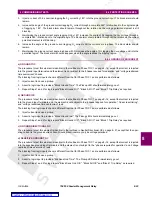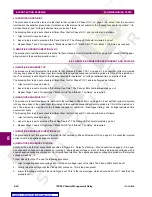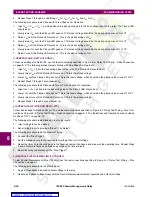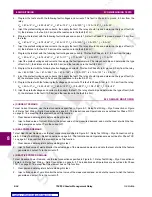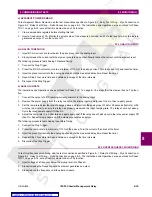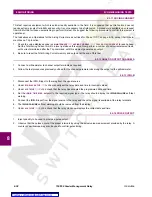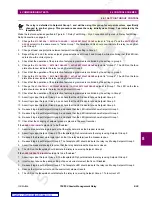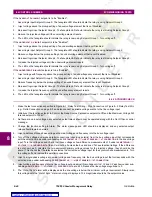
8-34
750/760 Feeder Management Relay
GE Multilin
8.5 MONITORING
8 COMMISSIONING TESTS
8
4.
Program the test set with the following fault voltages and currents. This fault is Phase B to ground, 6.0 km from the
relay.
V
an
= 67.4
∠
2°;
V
bn
= 60.3
∠
242°;
V
cn
= 67.4
∠
122°;
I
a
= 2.9
∠
330°;
I
b
= 12.0
∠
166°;
I
c
= 2.9
∠
90°
5.
Inject the prefault voltages and currents, then apply the fault. The relay should trip and determine the type of fault (B-
G), the distance to the fault (6.0 km) and the reactance to the fault (3.27
Ω
).
6.
Program the test set with the following fault voltages and currents. This fault is Phase C to ground, placed 7.0 km from
the relay.
V
an
= 67.4
∠
2°;
V
bn
= 67.4
∠
242°;
V
cn
= 61.3
∠
120°;
I
a
= 2.9
∠
330°;
I
b
= 2.9
∠
210°;
I
c
= 9.9
∠
47°
7.
Inject the prefault voltages and currents, then apply the fault. The relay should trip and determine the type of fault (C-
G), the distance to the fault (7.0 km) and the reactance to the fault (3.82
Ω
).
8.
Program the test set with the following fault voltages and currents. This fault is Phase A to C, 8.0 km from the relay.
V
an
= 60.4
∠
4°;
V
bn
= 67.4
∠
242°;
V
cn
= 61.7
∠
117°;
I
a
= 11.4
∠
253°;
I
b
= 2.9
∠
210°;
I
c
= 11.4
∠
73°
9.
Inject the prefault voltages and currents, then apply the fault parameters. The relay should trip and determine the type
of fault (A-C), the distance to the fault (8.0 km) and the reactance to the fault (4.36
Ω
).
10. Program the test with the following fault voltages and currents. This fault is Phase A to B, placed 9.0 km from the relay.
V
an
= 62.2
∠
358°;
V
bn
= 61.0
∠
244°;
V
cn
= 67.4
∠
122°;
I
a
= 10.3
∠
313°;
I
b
= 10.3
∠
133°;
I
c
= 2.9
∠
90°
11. Inject the prefault voltages and currents, then apply the fault. The relay should trip and determine the type of fault (A-
B), the distance to the fault (9.0 km) and the reactance to the fault (4.91
Ω
).
12. Program the test with the following fault voltages and currents. This fault is Phase A to B to C, 10.0 km from the relay.
V
an
= 60.3
∠
0°;
V
bn
= 60.3
∠
240°;
V
cn
= 60.3
∠
120°;
I
a
= 10.8
∠
283°;
I
b
= 10.8
∠
163°;
I
c
= 10.8
∠
43°
13. Inject the prefault voltages and currents, then apply the fault. The relay should trip and determine the type of fault (A-B-
C), the distance to the fault (10.0 km) and the reactance to the fault (5.45
Ω
).
8.5.3 DEMAND MONITORING
a) CURRENT DEMAND
To test Current Demand, use the test connections specified in Figure 8–1: Relay Test Wiring – Wye Connection or Figure
8–2: Relay Test Wiring – Delta Connection on page 8–3. The Indications and Operations are as outlined for Phase TOC 1
on page 8–16, except that this element has no Trip function.
1.
Clear demand data registers before starting this test.
2.
Inject a fixed value of current. Monitor the actual value of the measured demand, and note the level at which the fea-
ture generates an output. Turn the current off.
b) REAL POWER DEMAND
To test Real Power Demand, use the test connections specified in Figure 8–1: Relay Test Wiring – Wye Connection or Fig-
ure 8–2: Relay Test Wiring – Delta Connection on page 8–3. The Indications and Operations are as outlined for Phase TOC
1 on page 8–16, except that this element has no Trip function.
1.
Clear demand data registers before starting this test.
2.
Inject a fixed value of watts. Monitor the actual value of the measured demand, and note the level at which the feature
generates an output. Turn the current off.
c) REACTIVE POWER DEMAND
To test Reactive Power Demand, use the test connections specified in Figure 8–1: Relay Test Wiring – Wye Connection or
Figure 8–2: Relay Test Wiring – Delta Connection on page 8–3. The Indications and Operations are as outlined for Phase
TOC 1 on page 8–16, except that this element has no Trip function.
1.
Clear demand data registers before starting this test.
2.
Inject a fixed value of vars. Monitor the actual value of the measured demand, and note the level at which the feature
generates an output. Turn the current off.




